Ensuring your suspension is set up properly is vital to getting the most from your mountain bike. Achieving the correct 'sag figure' is a vital step to set up your mountain bike suspension.
For most modern mountain bike shocks (our mountain bike rear suspension systems guide sets out the differences) that means adjusting the air pressure inside the spring – and to do that you'll need a shock pump. While on the topic, you might also want to know: what is a high-pivot mountain bike?
Compared to the best bike pumps, most shock pumps are designed to reach up to 300psi without straining a muscle or busting a seal.
Shock pumps are something traditionally given for free with the purchase of a full-suspension mountain bike or aftermarket suspension product, for example the best mountain bike suspension forks.
However, we’ve recently seen a trend for the best downcountry mountain bikes and best trail mountain bikes to no longer include them as part of the package, so we thought it was time to find out which is best.
Below, we review nine shock pumps to see what the options are. Keep in mind that many of these pumps come out of the same factory, and so many share damning similarities – as apparent by the key measurements.
Each pump was assessed on its general usability, comfort and build quality. Additionally, we recruited Brady Kappius to custom-build a high-accuracy inline gauge to ensure repeatable results in our testing. With this, our benchmark digital gauge offers 1 per cent verified accuracy.
For more on how a shock pump works and the features to look out for, scroll down to our buyer's guide.
Best shock pumps 2025, as rated by our expert testers
Syncros SP1.0 Digital shock pump
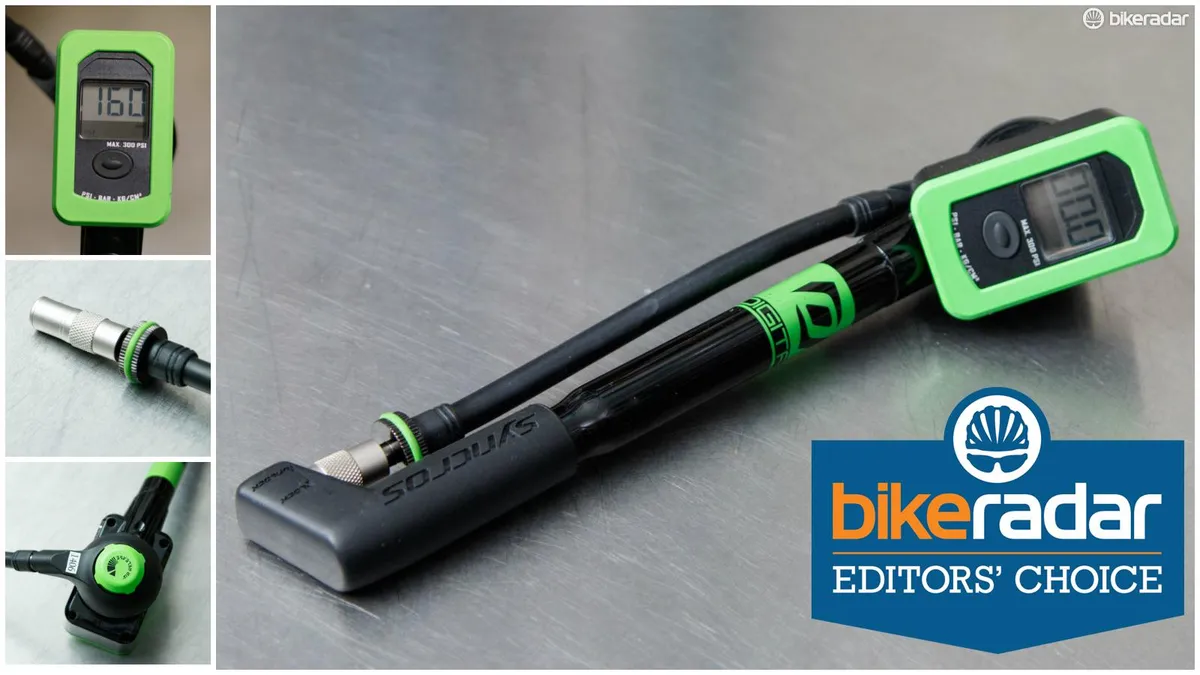
- Strokes to 160psi: 120
- Gauge pressure (at 160psi actual): 160psi
- Weight: 274g
- Folded length: 231mm
- Hose length: 195mm
- Price: £70 / $110 / AU$150
While expensive, the SP1.0 is also one of the best shock pumps. The digital gauge is accurate, and its angled design provides for a comfortable hold.
The shock pump’s head borrows a similar pin-drive mechanism to that of the Topeak DXG (see below), and so threading onto the valve and releasing the pressure pin is done in two stages.
Bleeding pressure was also the best, with a knob that can be opened exactly how you wish. The whole pump is fairly compact, although it’s not light to ride with.
This model has been replaced by the Syncros SP2.0 shock pump.
RockShox High Pressure Digital shock pump
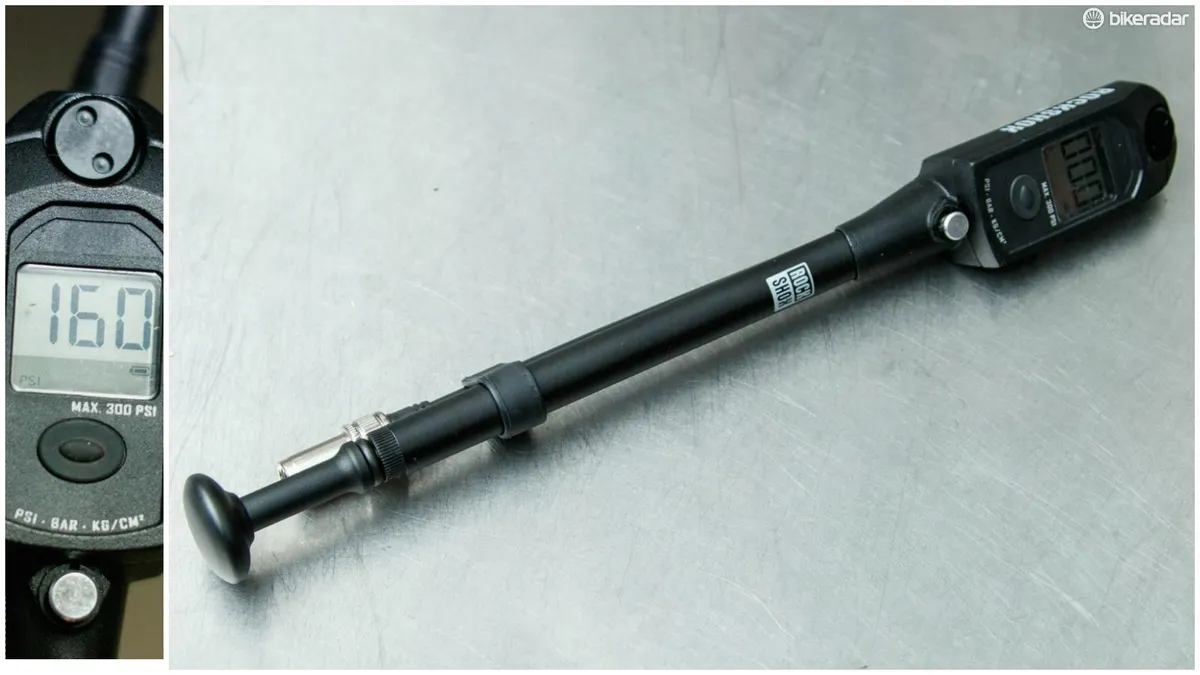
- Strokes to 160psi: 123
- Gauge pressure (at 160psi actual): 160psi
- Weight: 216g
- Folded length: 289mm
- Hose length: 255mm
- Price: £60 / $80 / AU$106 / €72
The RockShox High Pressure Digital shock pump ticks all the boxes for anyone seeking a little more precision in their suspension setup.
The gauge proved to be equal to the best shock pumps, such as the Syncros, but an otherwise simpler and more familiar construction brings the price down.
Birzman Zacoo Macht shock pump
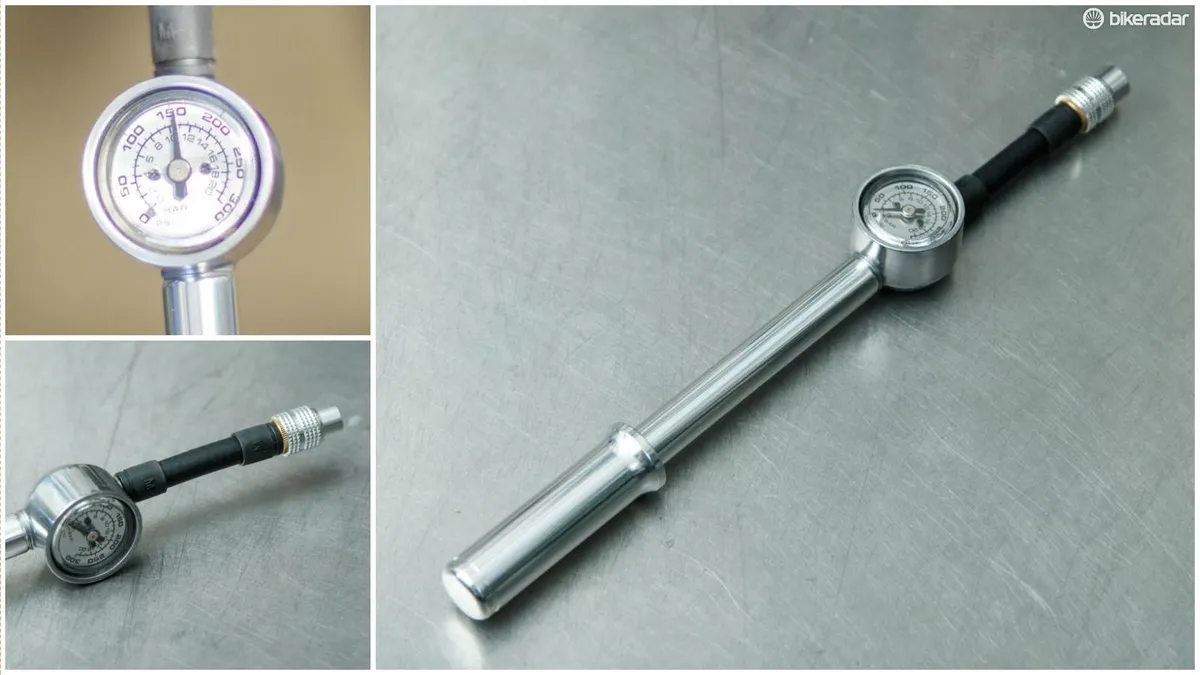
- Strokes to 160psi: 208
- Gauge pressure (at 160psi actual): 155psi
- Weight: 82g
- Folded length: 232mm
- Hose length: 70mm
- Price: £35 / $58 / AU$77 / €52
Built as the smaller and travel-friendly sibling to Birzman's Zacoo Salut, the Macht shares similar features.
At just 84g, it’s one of the lightest shock pumps – something that became an obvious trade-off when inflating shocks from scratch. At 70mm, the hose length is the shortest on test, so reach to some rear shocks may be a fiddle.
The minimal 1in gauge is surprisingly accurate, and the countersunk bleed button behind it is a nice addition for such a compact pump.
We can’t recommend this one for workshop use, but it’s among the best shock pumps for travelling and riding.
Topeak PocketShock DXG
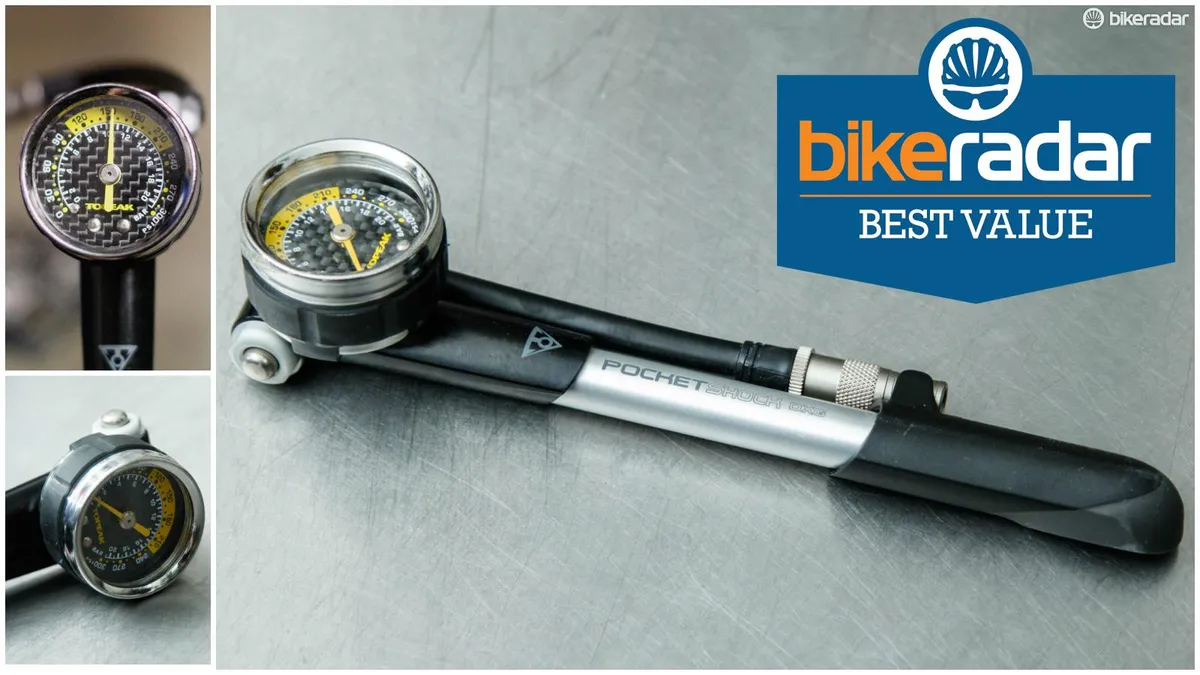
- Strokes to 160psi: 131
- Gauge pressure (at 160psi actual): 154psi
- Weight: 176g
- Folded length: 206mm
- Hose length: 145mm
- Price: £38 / $41 / AU$56 / €37
Lighter and with more features than the more generic options, the Topeak PocketShock DXG is clearly different.
The Topeak uses a ‘Pressure-Rite' connector for separate valve attachment and needle engagement.
At a portable 176g and with an easily read gauge that sits close to absolute accuracy, the PocketShock DXG is our best shock pump with an analogue dial.
Our only major gripe is with the placement of the bleed valve, which can be used accidentally.
Lezyne Shock Drive
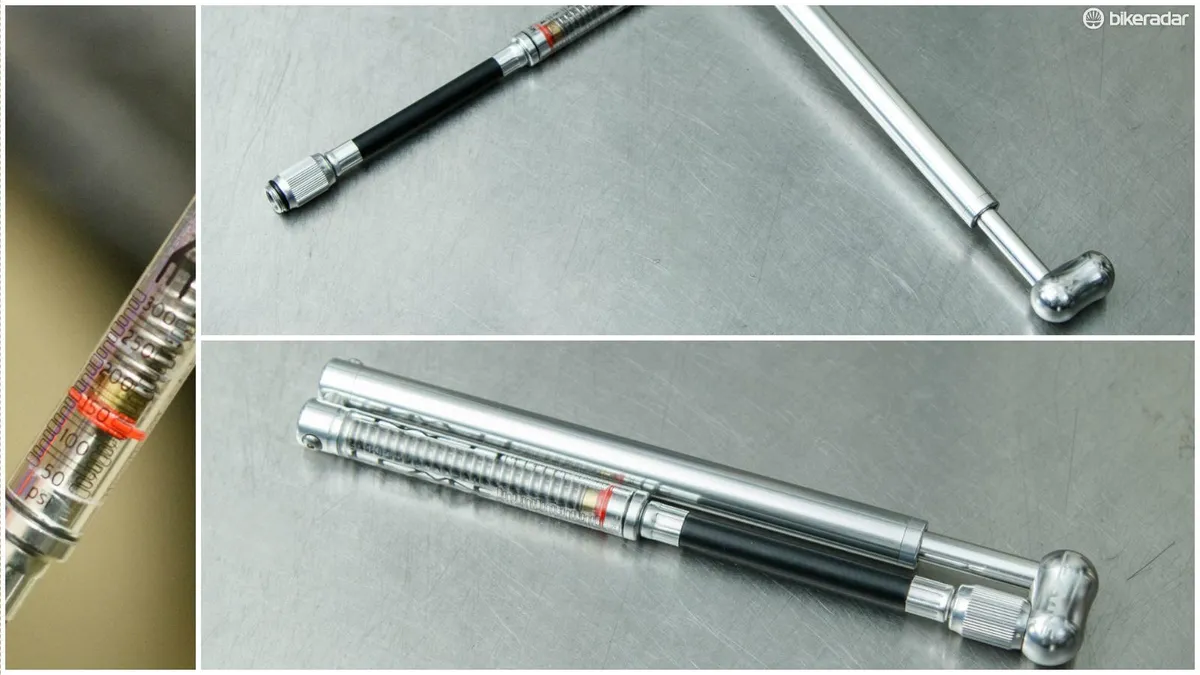
- Strokes to 160psi: 113
- Gauge pressure (at 160psi actual): 150psi
- Weight: 92g
- Folded length: 210mm
- Hose length: 117mm
- Price: £39/ $51 / AU$68 / €46
With a shiny alloy construction, the Lezyne Shock Drive has been built as an incredibly compact and lightweight travel/ride shock pump.
Its efficient inflation is up there with the best shock pumps and at 92g, it’s only marginally heavier.
But its inline gauge can be hard to get an accurate read from.
The build quality and design thought of this pump is undeniable, right down to the hose that threads back into the handle to seal the pump when not in use.
RockShox High Pressure 600psi
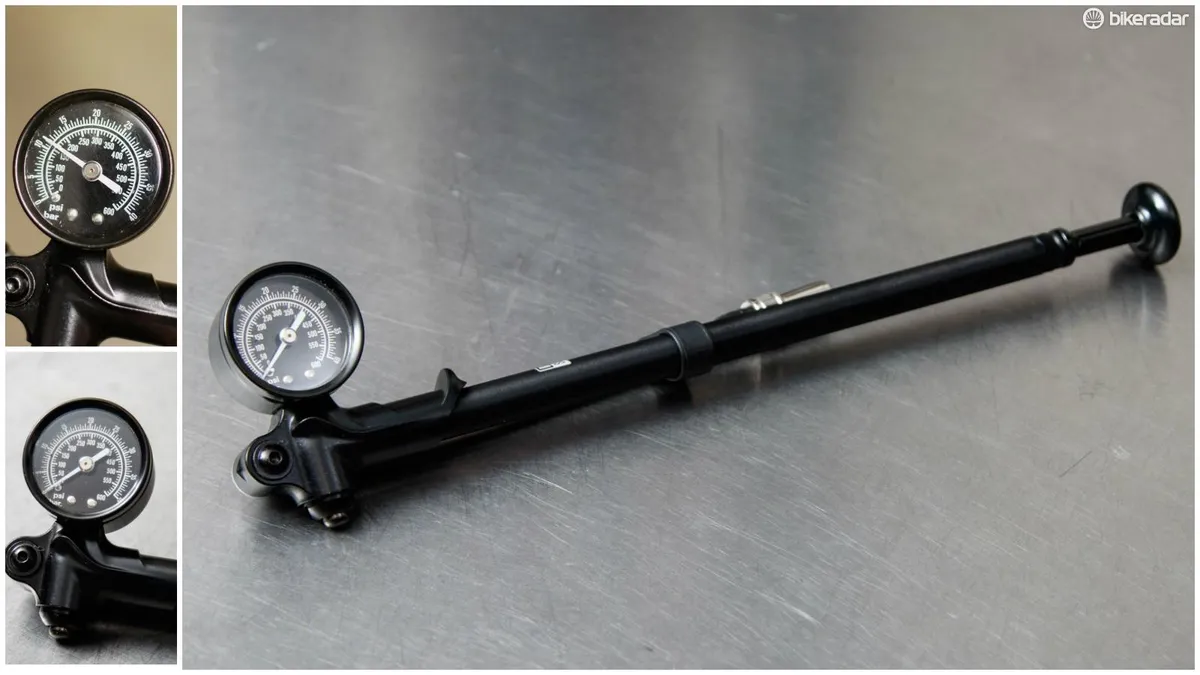
- Strokes to 160psi: 99
- Gauge pressure (at 160psi actual): 160psi
- Weight: 252g
- Folded length: 340mm
- Hose length: 210mm
- Price: £40 / $53 / AU$70 / €47
Built for servicing the internals of RockShox rear shocks and inflating the newest BoXXer forks, the RockShox High Pressure 600psi pump offers double the maximum pressure of the best shock pumps.
With such a high maximum pressure, we found it surprisingly good at lower pressures too; although double the numbers in the same gauge space does inevitably mean a loss of accuracy. So be warned that the gauge is tough to read at lower pressures.
It obviously serves a purpose for those working with specific needs, though its 340mm folded length makes it one best left in the workshop.
Topeak Shock 'n Roll
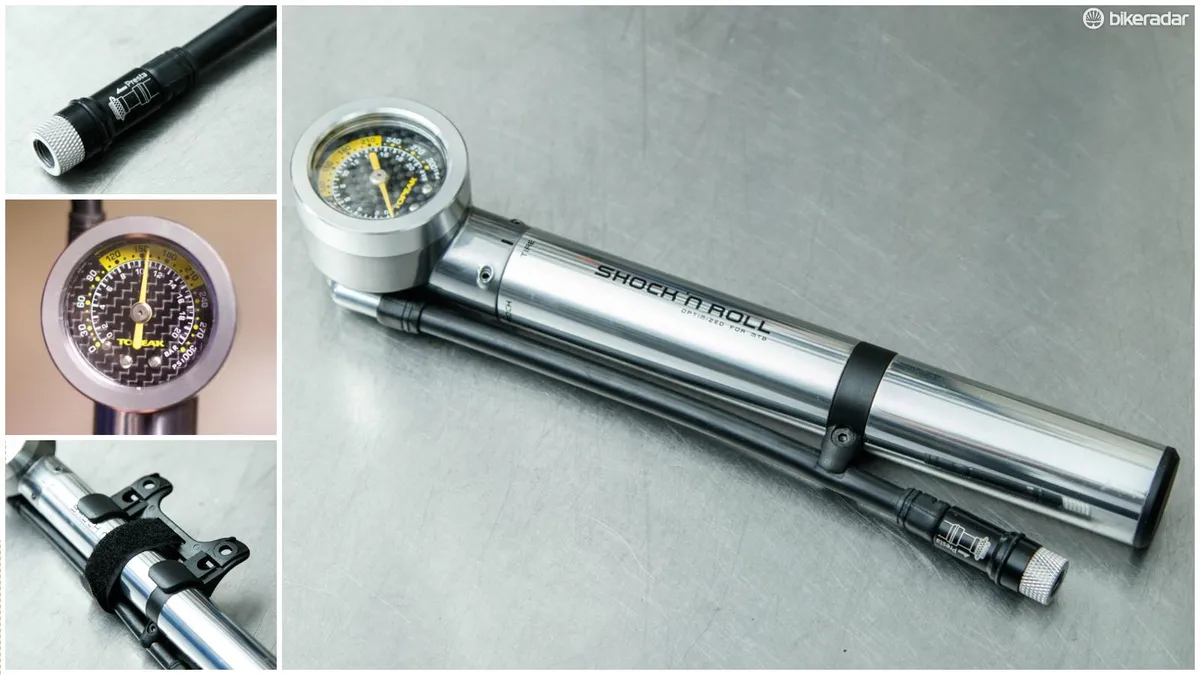
The only dual-purpose shock and tyre pump on test, the Topeak Shock 'n Roll is unique on this list. Twisting between the two labelled settings is simple, although the Presta-Schrader valve is less intuitive.
At 284g and 250mm long, it’s an impressive combination of two pumps, especially given so many mini tyre pumps do without a gauge.
If you want both pumps in one, this is simply your one and only good choice. It’s also the only pump on test to include an under bottle-cage mount – in case you’re keen to get it covered in mud.
However, the best shock pumps are more comfortable to use at pressure, and there are more efficient standalone tyre mini pumps out there for a whole lot less money if you don’t need the shock feature.
- Strokes to 160psi: 144
- Gauge pressure (at 160psi actual): 158psi
- Weight: 284g
- Folded length: 250mm
- Hose length: 215mm
- Price: £56 / $73 / AU$98 / €66
RockShox High Pressure 300psi shock pump
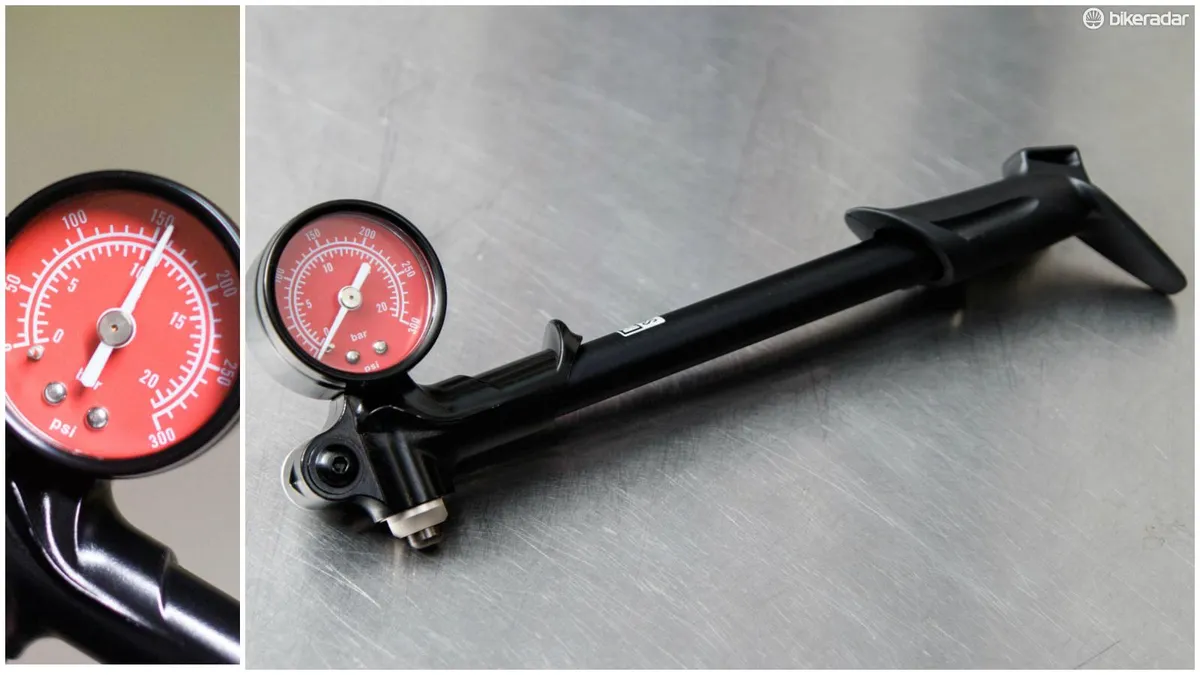
A newer, slightly revised version of the older pumps, this RockShox High Pressure shock pump is a safe choice if you’re seeking basic features. It proved efficient in inflation, closely accurate and simple to use.
There’s little doubt this one shares its design with some of the best shock pumps, but that’s not necessarily a bad thing assuming you can find it for the right price.
- Strokes to 160psi: 121
- Gauge pressure (at 160psi actual): 157psi
- Weight: 208g
- Folded length: 222mm
- Hose length: 210mm
- Price: £30 / $40 / AU$53 / €36
Birzman Zacoo Salut shock pump
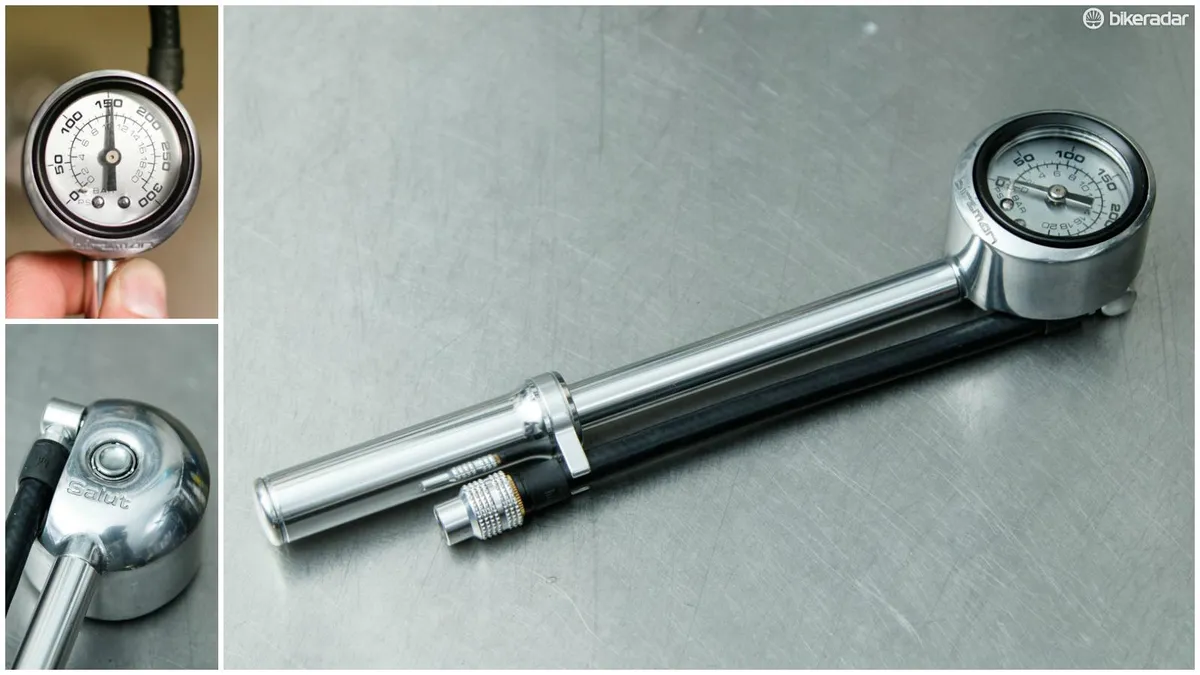
- Strokes to 160psi: 136
- Gauge pressure (at 160psi actual): 155psi
- Weight: 184g
- Folded length: 230mm
- Hose length: 180mm
- Price: £50
The polished-alloy construction makes the Birzman Zacoo Salut one of the nicest-looking shock pumps. A large gauge is easily read, and proved close to accurate.
A special zero-loss head is easily used, and the countersunk bleed valve is there to avoid accidental use.
The Birsman Zacoo Salut could compete with the best shock pumps without digital dials, but our sample then developed a sticky valve head that didn’t freely rotate. It's an issue that Birzman would cover under warranty, but we didn't experience the same problem with the others.
Shock pump buyer's guide
Gauge
This is one of the more important elements of a shock pump, as you’ll need to know what pressure you’re putting in, in order to set yourself a baseline for adjustment.
Of course, it's vital that you use the sag measurement – how far the suspension compresses with just your body weight on the bike – to set up your shocks initially, but knowing how much air you need to get there makes the whole process much more repeatable.
It’s here that small gauges fall short, because they can be hard to read and the general size of the needle and print can cause an error in desired pressure.
“There will always be some variability in how the gauge is read from person to person," Kappius Components' president Brady Kappius tells us. "And for this, a digital gauge increases the precision.”
It’s commonly said that the gauges on shock pumps only offer accuracy to within 3 to 5 per cent, and so for repeatable results it's best to use the same shock pump each time.
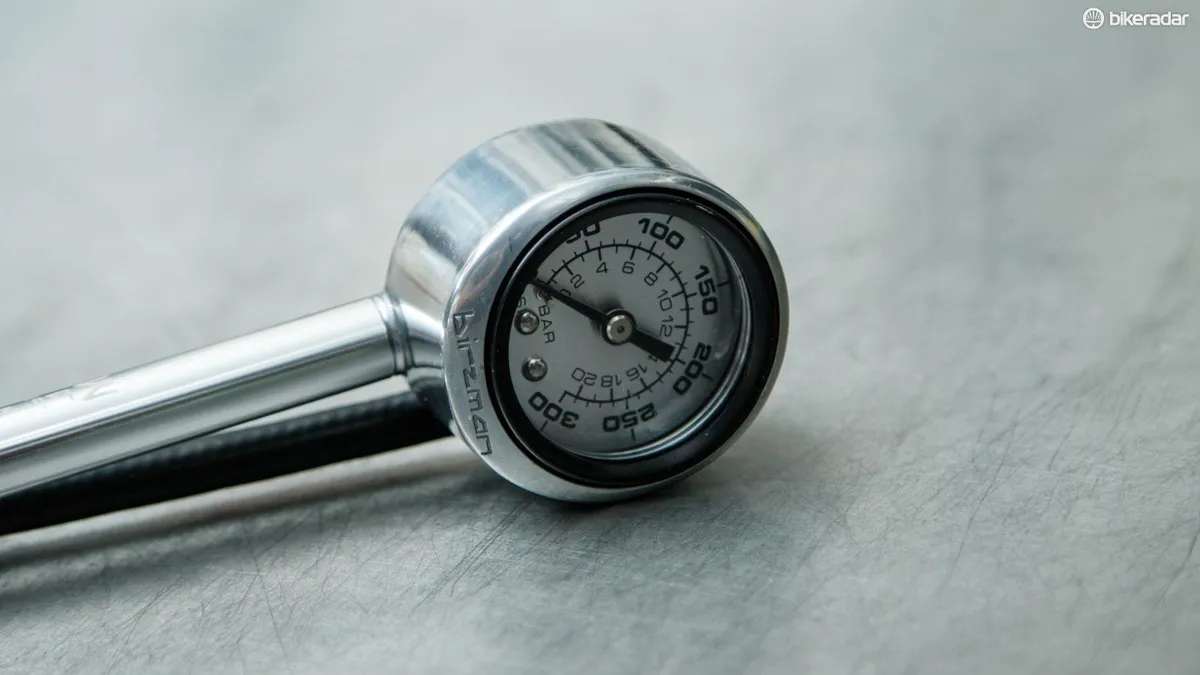
To learn more about the issues with gauge accuracy and precision, we consulted Josh Poertner, the CEO of pump manufacturer Silca.
“There is a very non-linear relationship between accuracy, precision and cost," he explains. "Accuracy and precision are different.
"I analogise it to throwing darts: accuracy is how close you are to the bullseye, so for a gauge, how close is 100psi to 100psi?
"Precision is how repeatable your darts are. If you aren't always hitting the 20 but you can tightly cluster your darts, you are inaccurate but precise. Similarly, if you hit left of bullseye, bullseye and right of bullseye, your average accuracy would be good, but your precision would be bad."
To counter such issues, Poertner suggests that whatever you choose to buy, you should treat it as a reference.
"If it's a shock pump, keep one in a box and use that one every time to set pressure," he says. "Use a different shock pump on the trail if you carry one along.
"Remember, all gauges, including digital, are subject to damage from shock, vibration and moisture, so keep your reference protected, clean, dry, and so on.”
Body
Without a body, the pump wouldn’t exist. With this, look for a pump that offers a comfortable hold and a durable material. Aluminium is a popular choice here for weight, strength and corrosion resistance.
Handle
With such high pressures, you’ll want a comfortable handle. Some pumps feature a fold-out handle, others offer little to grasp onto.
Hose
Just about every shock pump will feature a flexible high-pressure hose. That said, some frames feature tighter clearance than others and so a longer hose can come in handy.
Valve head
All shock pumps tested here use a Schrader valve (car valve).
One common argument is whether air is released from the suspension when the pump is disconnected, or if it's just air escaping from the pump.
Such pumps as those from Birzman, Syncros, Topeak and DT Swiss offer special ‘no-loss’ valves, while the others claim to offer no air loss without the obvious feature.
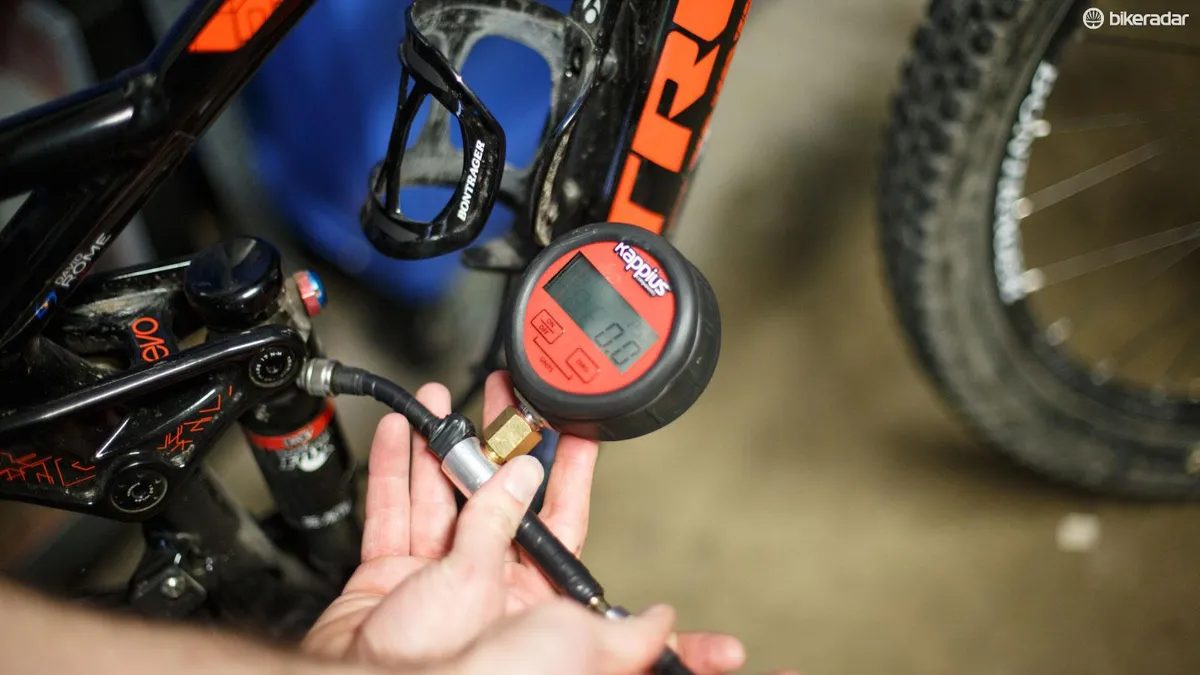
Bleed valve
A bleed valve is important for fine-tuning your suspension if there’s too much air. Most pumps here feature a basic button that lets you release bursts of air, while the Syncros takes a different approach.
Placement of the bleed valve can be a nuisance, with some pumps suffering from accidental release.
With our inline gauge, we inflated the same Fox rear shock (from fully compressed) to 160psi. We measured how many strokes the pump took to reach this pressure.
Additionally, we compared the pressure read-out a number of times on each pump to that of our verified gauge.
Due to the analogue gauges offering some discrepancy on how these can be read, we have included photos of each.
All but one of the pumps tested is rated to a maximum of 300psi (20 bar).